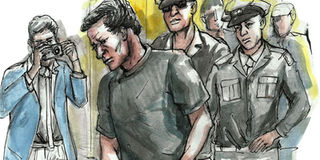DNA solves murder after 50 years

What you need to know:
- Confession. DeSalvo was not initially suspected of being involved with the strangling murders but after he was charged with rape, he gave a detailed confession of his activities as the Boston Strangler. He initially confessed to a fellow inmate and then later to a lawyer.
In the Boston area of Massachusetts in the US, 13 single women between the ages of 19 and 85 were murdered between June 14, 1962 and January 4, 1964. Most of the women were sexually assaulted in their apartments and then strangled with articles of clothing. The eldest, though, died of a heart attack while two others were stabbed to death, one of whom was badly beaten. Police and a parapsychologist with alleged extrasensory perception believed that one man was the perpetrator.
The last victim of the murders was Mary Sullivan, 19, who was assaulted and strangled with her own nylon stockings. Her killer left behind seminal fluid that was lifted from a maroon blanket that her body was covered with. This was the only DNA evidence that the Boston police preserved in the entire Boston Strangler investigation.
Most of the crimes were assumed to be the work of one unknown person dubbed “The Mad Strangler of Boston” after a newspaper declared “a mad stranger is loose in Boston”. The murderer was also known as the “Phantom Stranger” due to his ability to get women to allow him enter their apartments. In all the cases, there was no sign of forced entry and this made the police believe that the women let their assailant in, either because they knew him or because they believed him to be an apartment maintenance person, a delivery man or a service man. The murders, however, continued despite extensive media publicity after the first few murders, which, presumably, should have discouraged women from admitting strangers into their homes.
In 1964, in addition to the murders, the police were also trying to solve a series of rapes committed by a man who was dubbed the “Measuring Man” or the “Green Man”.
In October 1964, a stranger entered a young woman’s home posing as a detective. He tied his victim on her bed, proceeded to sexually assault her, and left suddenly, saying “I am sorry” as he went. The woman’s description led police to identify the assailant as Albert DeSalvo. And when his photo was published, many women identified him as the man who had sexually assaulted them.
Albert DeSalvo was born on September 3, 1931 to Frank and Charlotte DeSalvo. His father was a violent alcoholic. DeSalvo began shoplifting and stealing in early adolescence, frequently crossing paths with the law. He worked as a delivery boy after his first parole. He later joined the army and rose to the rank of a military police sergeant after which he was honourably discharged.
Confession
DeSalvo was not initially suspected of being involved with the strangling murders but after he was charged with rape, he gave a detailed confession of his activities as the Boston Strangler. He initially confessed to a fellow inmate and then later to a lawyer. The police were impressed by the accuracy of DeSalvo’s descriptions of the crime scenes. Although there were some inconsistencies in his confession, DeSalvo was able to cite details that had been withheld from the public.
However DeSalvo was never charged or convicted of the Boston murders as there was no physical evidence to substantiate his confession. DeSalvo was sentenced to life imprisonment for the multiple rapes he had committed and transferred to a maximum security prison. He was, however, stabbed and found dead in his cell under mysterious conditions in 1973.
The physical evidence linking him to the murders, in the form of a Y-Chromosome DNA analysis, was to come in July 2013, 50 years after the murders had taken place. The Y-Chromosome DNA is passed through the direct male lines with little change and can be used to link males with a common paternal-line ancestor.
The police first had to make sure that the Y-chromosome DNA in the samples stored was a familial match to DeSalvo’s DNA in order to convince a judge to let investigators disturb his grave. A police surveillance expert followed one of DeSalvo’s nephews, Tim DeSalvo, to his worksite in Boston and retrieved a water bottle he drank from and left behind.
The DNA from the bottle was a match to the samples collected from the 1964 murder of Mary Sullivan, excluding 99.9 per cent of the male population from suspicion in the murder and pointing to Albert DeSalvo with near certainty as the man responsible.
To determine conclusively that it was DeSalvo’s DNA, a court ordered the exhumation of his body to test his DNA directly. Authories exhumed DeSalvo’s remains later that month and confirmed the DNA match.



